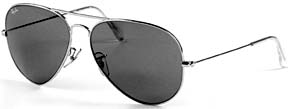
By Jonathan Spencer
Many a pilot will take a pass on the obligatory leather bomber jacket – it is, after all, a silly affectation for a guy in a Cherokee. But most of us want sunglasses. And for good reasons other than just looking cool at the airport bar. Sunglasses protect the eyes, improve the ability to spot traffic and wearing them in daylight gives your night vision an edge after the sun goes down.
We last examined sunglasses for pilots in 1995 and since then, quite a bit has changed. Market tastes have shifted, fashions have evolved and even the opinions of some experts on what constitutes the “right” sunglasses for pilots have changed. And the two biggest suppliers of pilot’s sunglasses have both been bought by conglomerates and are no longer the flagship product of each company.
In this article, we’ll work through the advertising hype on one hand and the research literature on the other and we’ll offer some recommendations for purchasing sunglasses. In a follow-up article, we’ll look at how specific brands measure up.
Why Wear Them?
There are good reasons for having a pair of sunglasses, some rooted in convincing science. If the lenses provide UV protection – not all do, including many that claim to – your eyes are shielded from UV damage, protection worth having if you’re in the sun a lot.
Preventing night blindness is one of the best reasons for wearing shades. Sunglasses can reduce night adaptation time from hours (or longer) to minutes. When your retina gets bleached repeatedly over the course of days or weeks, it can take days or weeks to recover completely.
Glare protection is another argument for sunglasses. It’s a major discomfort issue for some people, but sensitivity to glare varies widely from person to person. Somewhat disputed in the technical literature is the claim that sunglasses reduce eye fatigue due to glare; factors such as astigmatism are known to cause fatigue. Glare? Maybe.
Blue light protection is another argument for sunglasses. Since Galileo’s examination of the sun through his telescope, we’ve known that intense light can damage the retina. There’s some evidence, based on animal studies, that the retina is most easily damaged by blue light but we think it’s inconclusive, at best.
Some manufacturers claim that their sunglasses reduce squinting, which slows the formation of wrinkles around the eyes. (Sorry, nobody is claiming that wearing sunglasses will remove existing wrinkles). At least shades are cheaper than botox treatments.
UV Protection
UV protection, touted in most sunglasses ads, should be a non-issue but has become a confusing morass of standards, recommendations and regulations.First, some definitions: Light wavelength is generally measured in nanometers (nm), where one nm = 1 x 10-9 meters. The boundary between visible and UV (ultraviolet) light is somewhat arbitrary, since the wavelength where the change occurs differs from person to person. In the sunglasses industry, the boundary has been defined as 400 nm.

UV light is divided into three ranges of wavelengths based on the physical effects of the light in these ranges: UVA (315 to 400 nm) is responsible for tanning your skin, UVB (280 to 315 nm) is responsible for sunburn and skin cancer and UVC (100 to 280 nm) occupies the top of the spectrum. The atmosphere absorbs all of the UVC and 90 percent of UVB, so most of what reaches the surface is UVA.
Nonetheless, the 10 percent of UVB that slips past the atmospheric filter is what we worry about most. It’s widely considered to be responsible, in part, for cataracts, macular degeneration and other eye diseases. While the cause-and-effect relationship for this has been iffy to prove, most experts think the protection afforded by sunglasses is worth the small cost.
It’s worth emphasizing that neither the density nor the price of sunglasses tells you anything about their ability to block UV. Almost every pair of sunglasses you buy will have a label claiming UV protection. The label may mention the ANSI standard (it should cite ANSI Z80.3-2001) but many authorities think the ANSI standard on UV is weak.
For general purpose sunglasses, it requires 95 percent blocking of UVB and “at least 60 percent” blocking of UVA. Unfortunately, even these labels are not reliable. 20/20 Magazine, a trade publication of the optical industry, recently bought a variety of brand-name knockoffs in the $5 to $7 range in New York. Many of these bore the usual “100 percent UV Protected” stickers. But these stickers proved to be as untruthful as the brand logos; many fell we’ll short of meeting the ANSI requirements for UV protection.
The only real defense is to buy your sunglasses from a trusted source, preferably an eyewear professional who can vouch for their quality.
Blue Light
A lot of hay has been made of the blue light issue. Depending on whose advertising you read, blue light fails to focus on the retina, thereby causing “blue blur;” it scatters off haze particles, obscuring things you really want to see (other airplanes); it damages the retina.
There’s some truth to these claims. What’s not clear is whether, at normal light levels, any of these effects occur with sufficient intensity to matter to ordinary mortals, even pilots who, as we all know, aren’t ordinary mortals. Fortunately, we can dismiss them as non-issues as long as we wear sunglasses, since virtually all sunglasses filter out a significant percentage blue light. This doesn’t apply to blue sunglasses, of course, but then you shouldn’t be wearing blue sunglasses for flying.
Shopping: Materials
With these basics in mind, here’s what’s available and what to look for when shopping. Based on the foregoing, UV protection is a given. Insist on it. Four lens materials are generally in use, although a number of lens manufacturers have special materials, usually high-index material for strong prescriptions.
CR-39 plastic: This is the most common and the most versatile material. Optometrists and opticians like these lenses because they can be tinted, untinted and retinted with a short round-trip to the lab.
They’re lighter in weight than glass, can be easily ground to a prescription, readily take anti-reflective and scratch-resistant coatings and these coatings can be removed and re-applied at any time. They are more easily scratched than glass, but scratch-resistant coatings compensate.
Downside: Tints applied to CR-39 lenses can fade and discolor after a few years, although they can be retinted.
Glass: Glass is the heaviest of the available materials and the most scratch-resistant. Glass is tinted by tinting the material itself, so the tint is put into the lens at the factory and colors are limited to those available from the manufacturers.
Because the tint is in the glass, prescription sunglasses sometimes have an uneven tint, darker where the glass is thicker and lighter where the glass is thinner. This is known in the optical industry as the “raccoon-eyes” effect. But it’s rarely an issue, except for strong prescriptions.
Anti-reflective and UV coatings are available for glass lenses. Scratch-resistant coating is not necessary.
Glass is also the most fragile of the materials and our consulting optometrist says his patients have to give him a good reason why they want glass to convince him to prescribe them. The most common cause of shattered lenses is automotive airbags.
Polycarbonate plastic: Polycarbonate plastic is also sold under the brand name Lexan. It’s the strongest of the available materials.
Because raw polycarbonate plastic is easily scratched, these lenses come from the factory with a scratch-resistant coating. (If your eyewear professional wants to add a scratch-resistant coating to the cost of your polycarbonate lenses, go elsewhere.)
Polycarbonate sunglasses are made by buying lenses from the manufacturer that have the requested color at about 50 percent density. The local lab then tints them to the finished density. Because the final tint goes into the factory-applied scratch-resistant coating, the tint cannot be changed or removed.
Our consulting optometrist tells us that he urges all his patients to get polycarbonate lenses because of their ability to withstand impact damage. He says that liability concerns are pushing the industry towards polycarbonate and predicts that in a few years, most lenses will be of this material. He estimated that a pair of prescription bifocals would cost about $50 more as polycarbonates than as CR-39 plastic.
High-index plastics: These are used primarily for patients with strong prescriptions where CR-39 plastic would appear too thick. Most high-index plastics have characteristics similar to polycarbonate.
Tint
The three basic colors that pilots use most haven’t changed in years: gray, green (really gray-green), and brown. Some manufacturers (notably Serengeti) add filters to modify the basic colors. The filters attenuate – but don’t completely block – pecific portions of the spectrum to improve contrast or make some colors look brighter at the expense of others. Filters are usually not a coating but a chemical modification of the lens material.
There are also special-purpose colors, such as yellow and red, and fashion colors such as blue and purple. A tint, by definition, blocks some portions of certain colors.
Brown lenses, for example, partially block blue light, while green partially blocks both blue and red. Gray is the least distorting color, since it blocks all colors equally.
Note that phrases such as “blocks all colors equally” have to be understood in the context of optical spectra. It’s rare for a lens to have a flat spectrum. Gray lenses have a flatter spectrum than green or brown lenses. (See the sidebar on spectra.)
Some people are bothered by color distortion more than others. And certain tints may make certain colors hard to see. This is especially true for people with mild color-blindness.
Any sunglasses that meet ANSI Z80.3-2001 should allow you to see any color you need to, including red, orange, yellow, green and blue. Whether the color distortion is bothersome, however, is a personal issue.
Some special-purpose lenses take color distortion to an extreme. Yellow lenses, for example, block blue light completely. Most experts argue against yellow lenses precisely because they eliminate all blue light.
One researcher cited a story of an airline pilot who discovered he had left the engine deicers on for the entire flight because the engine deicer lights are blue and looked black or off through his yellow lenses. Obviously, this was a benign error, but the point was that any lens that completely blocks a specific color is a potential hazard in the cockpit.
When we last examined this topic, the experts were fairly we’ll lined up behind brown lenses, based on military research that showed that lenses that block blue light improve visibility of distant objects in hazy conditions.
A 1991 NASA study found that lenses that blocked blue light seemed to improve pilots’ ability to spot traffic. The lenses used for testing, however, were distinctly red and did not resemble lenses that most pilots wore.
This time around, there seems to be less enthusiasm for brown lenses. Most of the experts seem to lean toward green and gray lenses because they preserve color balance. One possible reason for this is that the size of haze particles varies considerably, depending on the source of the haze.
Different size haze particles scatter different wavelengths of light. So you may find your Serengetis work better on some hazy days than on others.
Another reason is that most green-tinted lenses now block blue light as we’ll as the brown-tinted ones do. The main difference is that green lenses also partially block parts of the red spectrum, leaving just the center of the spectrum where the eye is most sensitive.
Even Serengeti, the major proponent of the brown lens, now offers a green lens, which they call their “555nm” lens, named for the center wavelength of green light.
Last, vanity. Yes, in addition to the issues of how you see, there’s also the issue of how you look. Our consulting optometrist noted that green lenses may be a good choice but many feel they don’t look good in green lenses,
Density
Density is a confusing issue. You’ll see densities described as a light-blocking percentage or a light-transmittance percentage. One is the inverse of the other, so a light-blocking value of 85 percent is equivalent to a light-transmittance value of 15 percent, meaning it allows only 15 percent of the light hitting the lens to pass through. To eliminate one source of confusion, we’ll use light-transmittance exclusively.
Amazingly, you can find sunglasses that meet the ANSI standard with light-transmittances values ranging from virtually clear to 3 percent. ANSI divides sunglasses into three categories with the lenses that pilots use falling into the general purpose category of 8 to 40 percent transmittance. Many studies have tried to pin down the ideal density of sunglasses; few agree.
Unfortunately, most sunglasses come with no indication of their density, so all this research doesn’t help much. And few eyewear professionals have instrumentation to accurately measure density, in any case.
A quick-and-dirty test is to look at yourself in a mirror indoors while wearing the sunglasses. If you can see your eyes easily, the sunglasses are not dense enough. Slightly better is to compare a lens with a lens of known density, which eyewear professionals should have on hand.
In the end, however, you have to live with your sunglasses, so they should be comfortable for you. But remember that you may not be able to tell what’s comfortable in your airplane and your car until you try them in both places, so buy from a store that will permit returns. If you buy prescription lenses made of CR-39 plastic, your shop can change the tint – both color and density – with a quick round-trip to the lab.
Photochromic Lenses
If a single-density lens doesn’t cover all your needs, photochromic lenses might. These lenses change density as the intensity of the ambient light changes – the brighter the ambient light, the darker the lenses.
Photochromic lenses come in both glass and plastic. Eight years ago, the glass versions were much better than the plastic. Today, the performance gap has narrowed, but glass is still better, where better means wider density range and faster rate of change, which pilots will want.
There are many versions of photochromic lenses. Some, like Serengeti’s Drivers, are variable sunglasses, varying from medium (24 percent light-transmittance) at low ambient light levels, to very dark (9 percent light-transmittance) in high ambient light levels. Others, like some of the PhotoGray lenses, try to cover the entire range from regular lenses to sunglasses, varying from almost clear to fairly dark (17 percent light-transmittance).
Nobody has yet created a lens that really changes from clear – more than 95 percent light transmittance – Sto dark, the 15 percent or less light-transmittance range. But PhotoGray comes close.
The biggest weakness of the photochromic lenses, however, is their dependence on UV light. All photochromic lenses work on the same principle – particles embedded in the glass or plastic change chemically when exposed to UV light and return to their original form when the UV light source is removed.
Most photochromic lenses don’t get dark enough in enclosed spaces like cars or aircraft because windows may block UV and photochromic lenses don’t reach their maximum darkness without direct exposure to UV. In most cars and cockpits, you quite intentionally have only indirect light on your eyes.
Also, photochromics can be slow to change. The change from light to dark is usually fairly fast, less than a minute in most cases. The change back from dark to light, however, can be longer, on the order of several minutes. This can be a problem if you’re descending rapidly from very bright conditions on top to fairly dark conditions underneath.
And finally, photochromic lenses – particularly plastic ones – are heat-sensitive. In hot conditions, they may not darken as much as usual and in cold conditions they may darken too much. Our best advice is find a way to try photochromics before buying.
Coatings
When you’re ordering sunglasses, a variety of coatings are available.
Scratch-resistant: A scratch-resistant coating is a worthwhile addition to CR-39 lenses, especially if you’re rough on glasses.
Don’t let anyone sell you a scratch-resistant coating for polycarbonate lenses, the material comes that way from the factory. And glass is considered hard enough that no scratch-resistant coating is required.
Anti-Reflective: This coating reduces reflections from the lens surface and also includes scratch resistance. The most annoying reflection is often from the inner surface, which in some conditions can almost completely block the view through the lens.
Some have reported that lenses with anti-reflective coatings are harder to keep clean. Our consulting optometrist notes that anti-reflective coatings clean up fine with soap and water dried with a facial tissue free of any lotion. A good alternative to soap and water is the cleaning solution that eyewear professionals give away in small bottles.
There are many types of anti-reflective coatings and not all labs do the best job with these. Once again, the shop’s return policy is your ace in the hole. Anti-reflective coating can be removed and reapplied to CR-39 lenses but not to polycarbonate lenses because the process that removes the anti-reflective coating also removes the factory-applied scratch-resistant coating, ruining the lens.
UV: As mentioned, UV coating is a worthwhile addition for most sunglasses. The exception is polycarbonate lenses, which block UV without any coating. UV coatings add a slight yellow color to the lens. For sunglasses, this is usually not noticeable, but it could be for clear lenses.
Gradient: Some sunglass manufacturers offer a gradient version of their lenses. (Serengeti Drivers is the best known of these.) This adds a coating that’s the same color as the tint but is darker at the top than the bottom, so that the density of the top half of the lens is greater than the bottom half. This is designed for pilots or drivers who want a less-restricted view of the instrument panel.
Many feel that gradients are less useful for pilots since the most glare a pilot experiences is frequently from a cloud layer below. It’s a personal choice but the option is there.
Polarizing: This one is easy and near-unanimous. Many instrument displays and aircraft windscreens are polarized. Most pilots who have tried polarized lenses have found them unsatisfactory. Short answer: Say no to polarized lenses.
In our next article, we’ll examine how specific brands – both lenses and complete glasses – measure up to the specs we’ve discussed.
Jonathan Spencer is a Cardinal owner and writer. He lives in Newton, Massachusetts. He can be reached at [email protected]. Dr. Ernest Loewenstein, (www.eyesdoc.com) served as a consultant for this article.


